
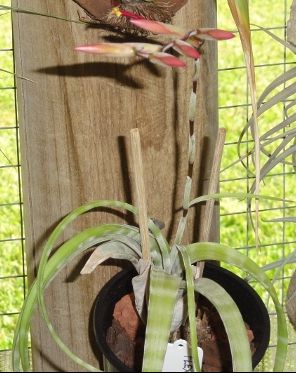
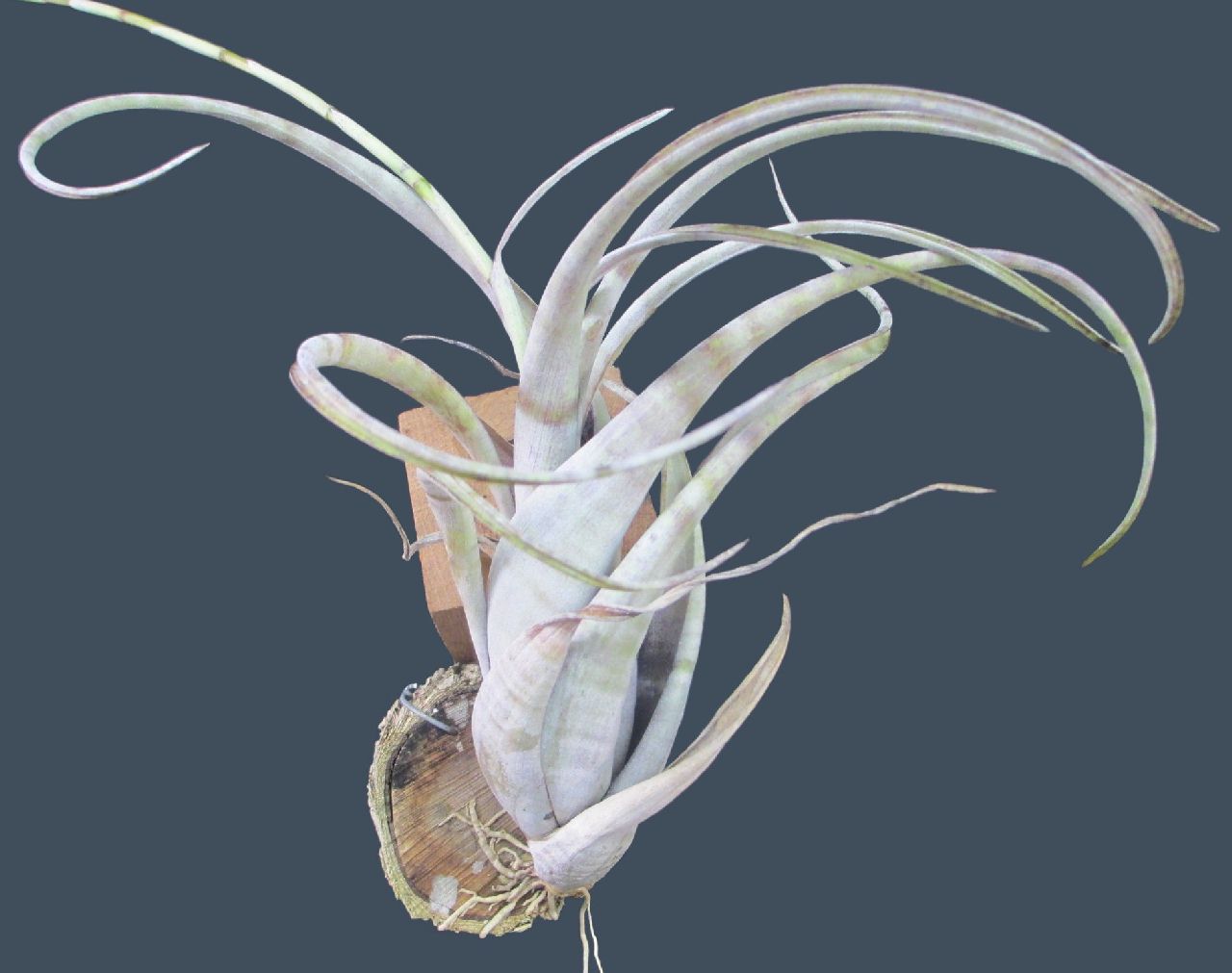
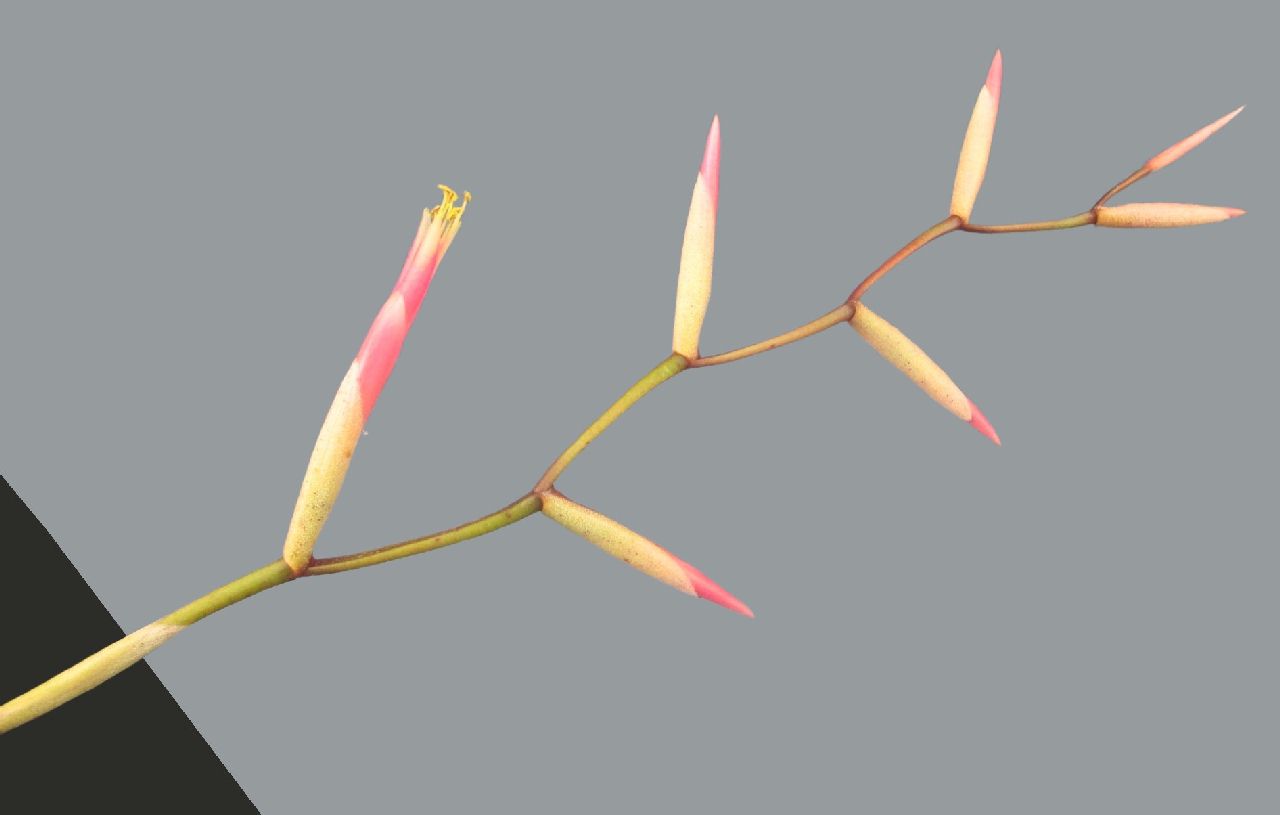
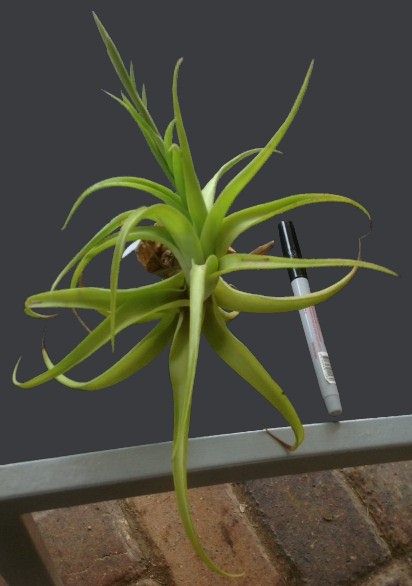
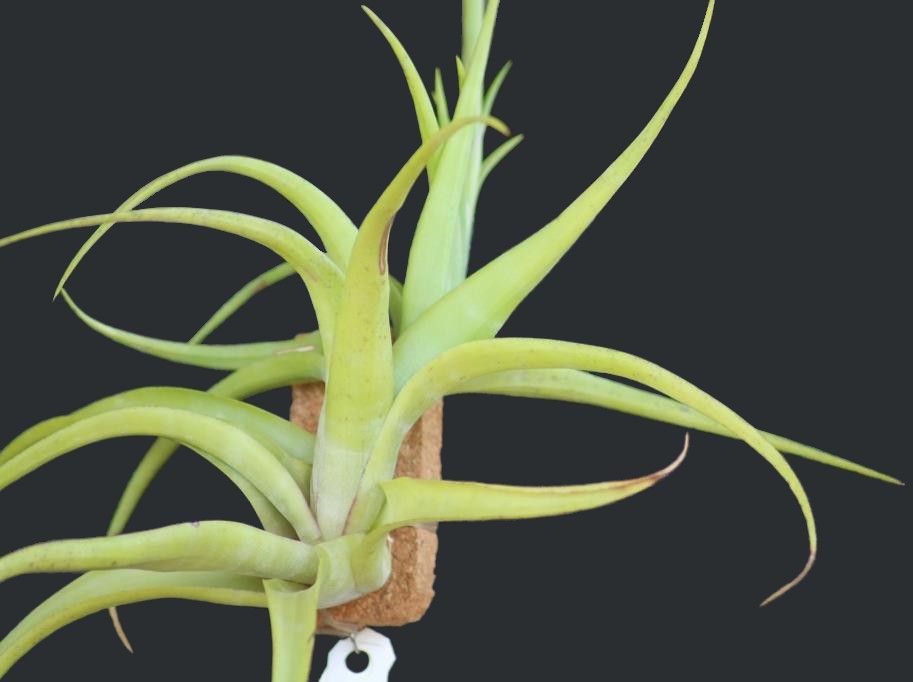
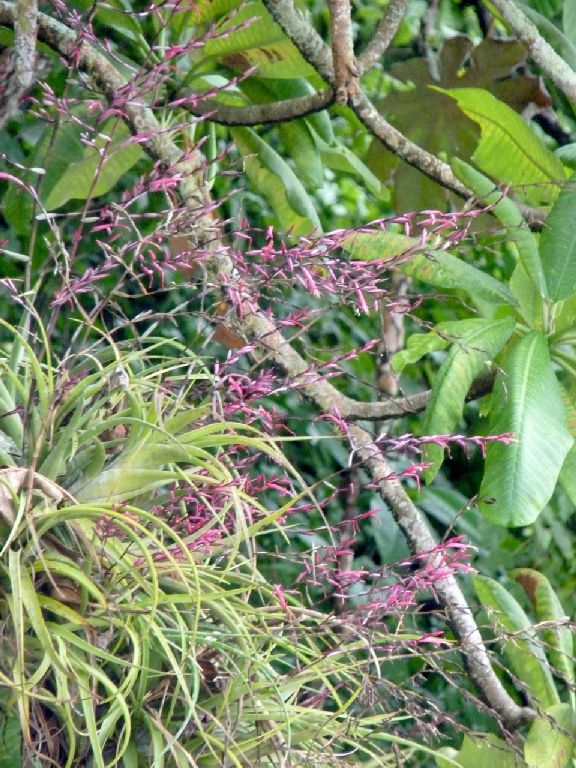
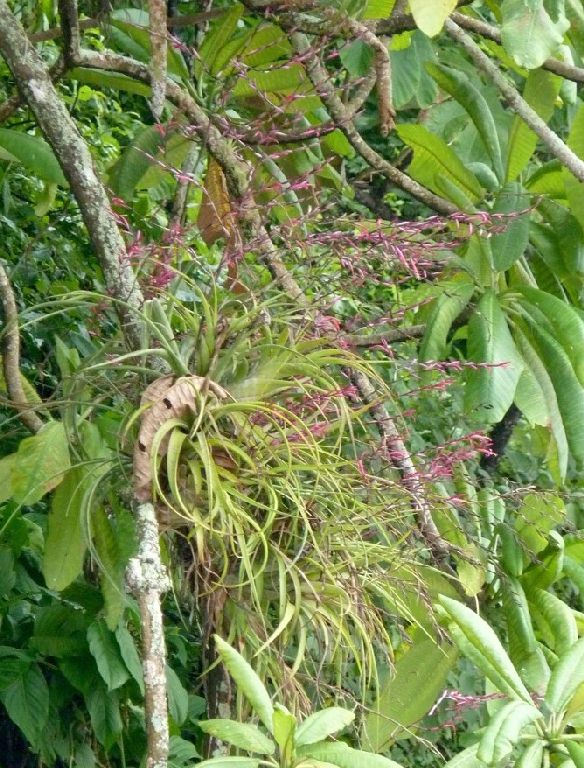
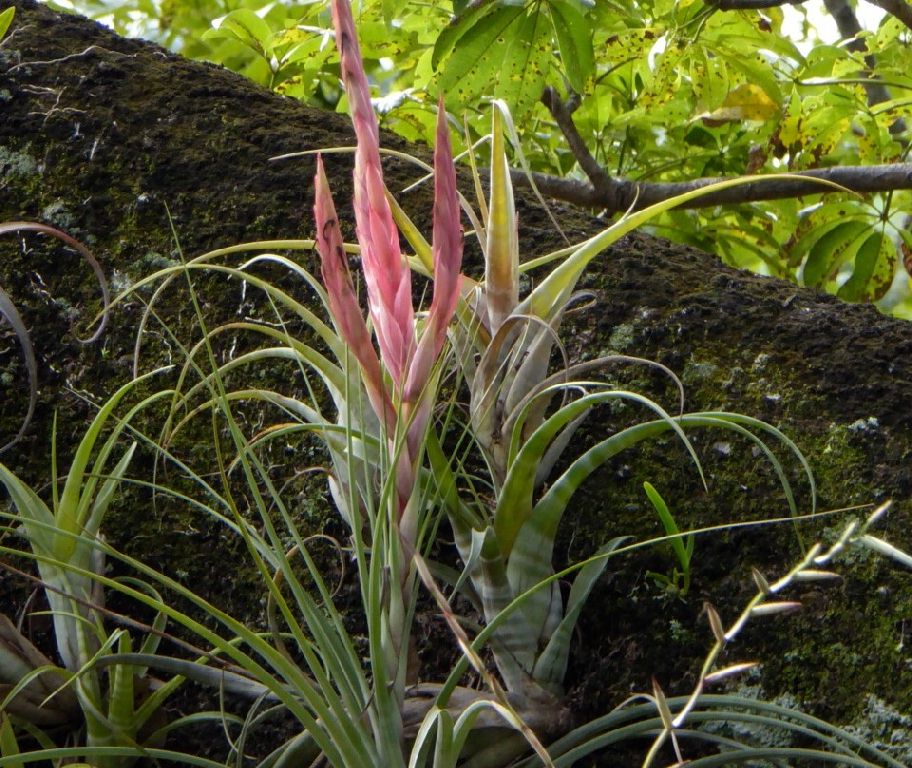
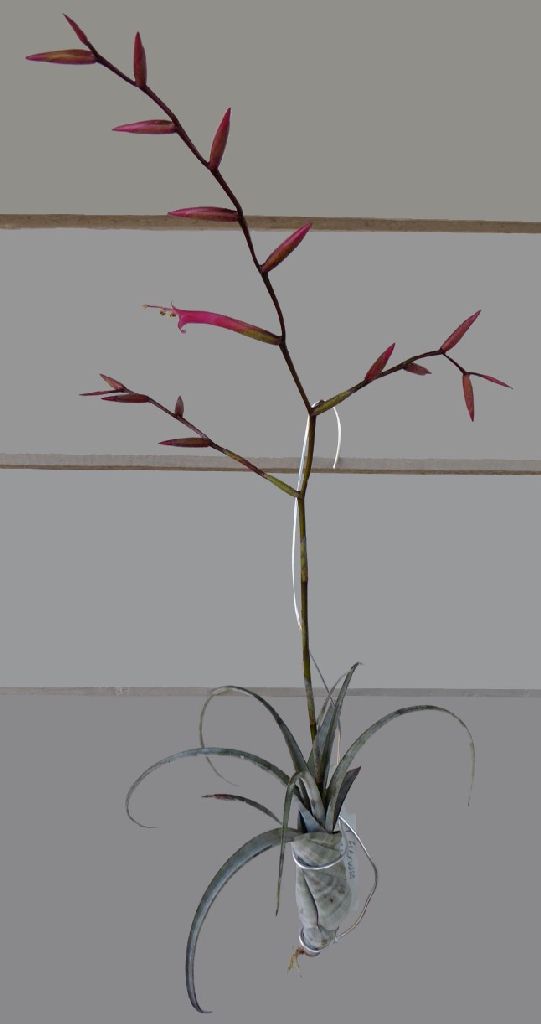

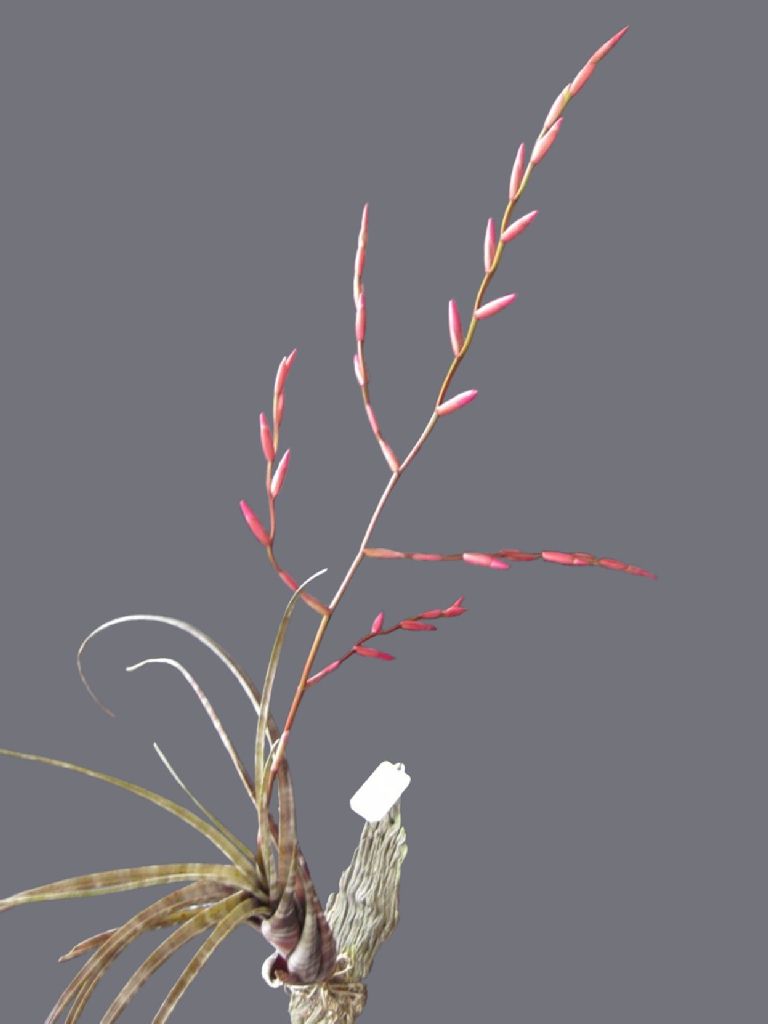
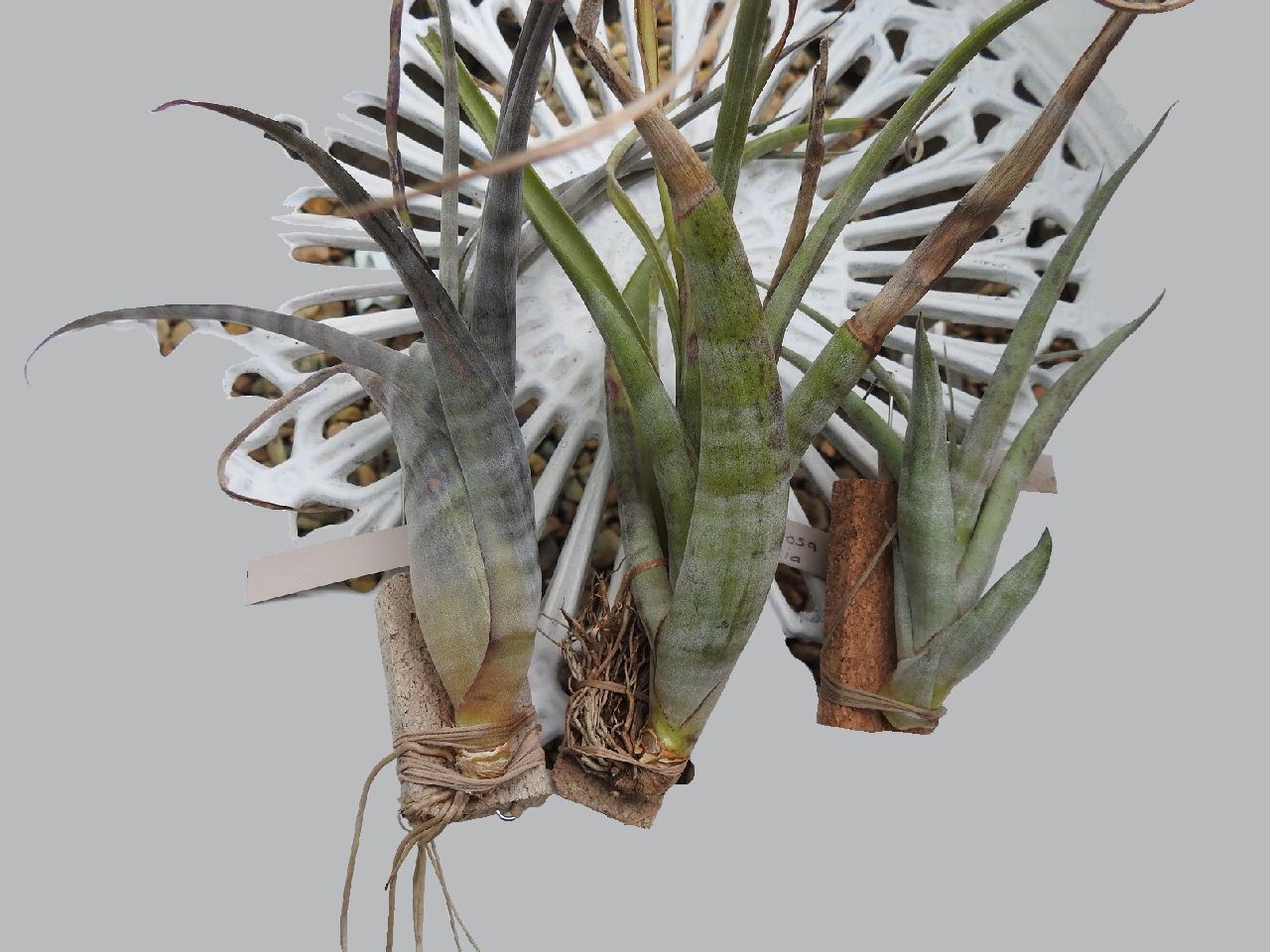
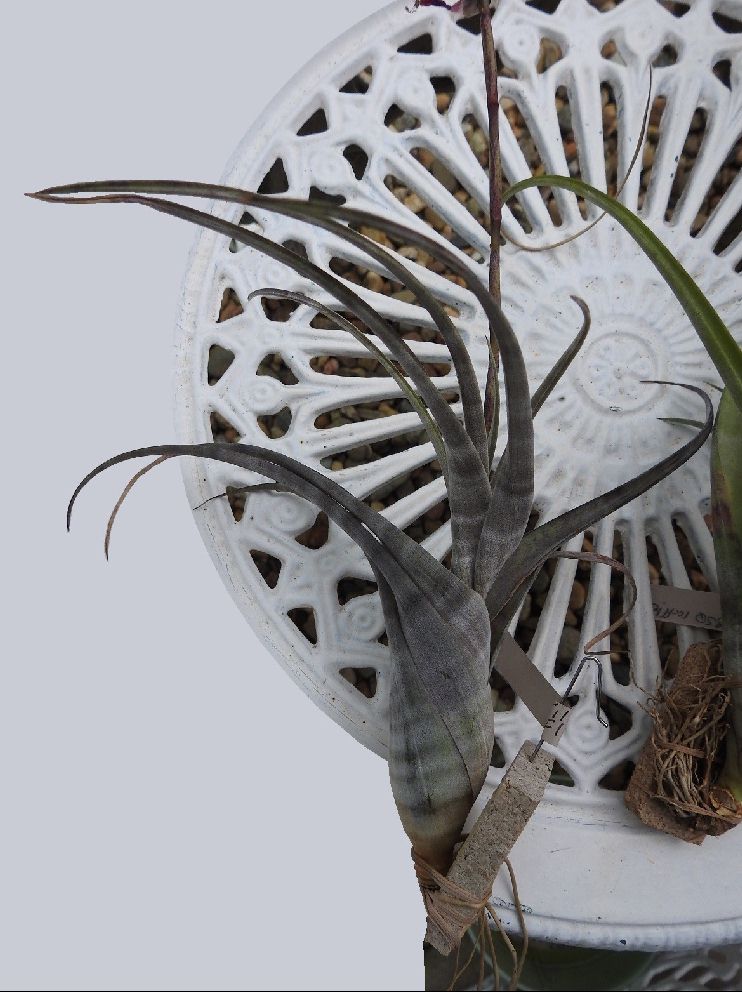
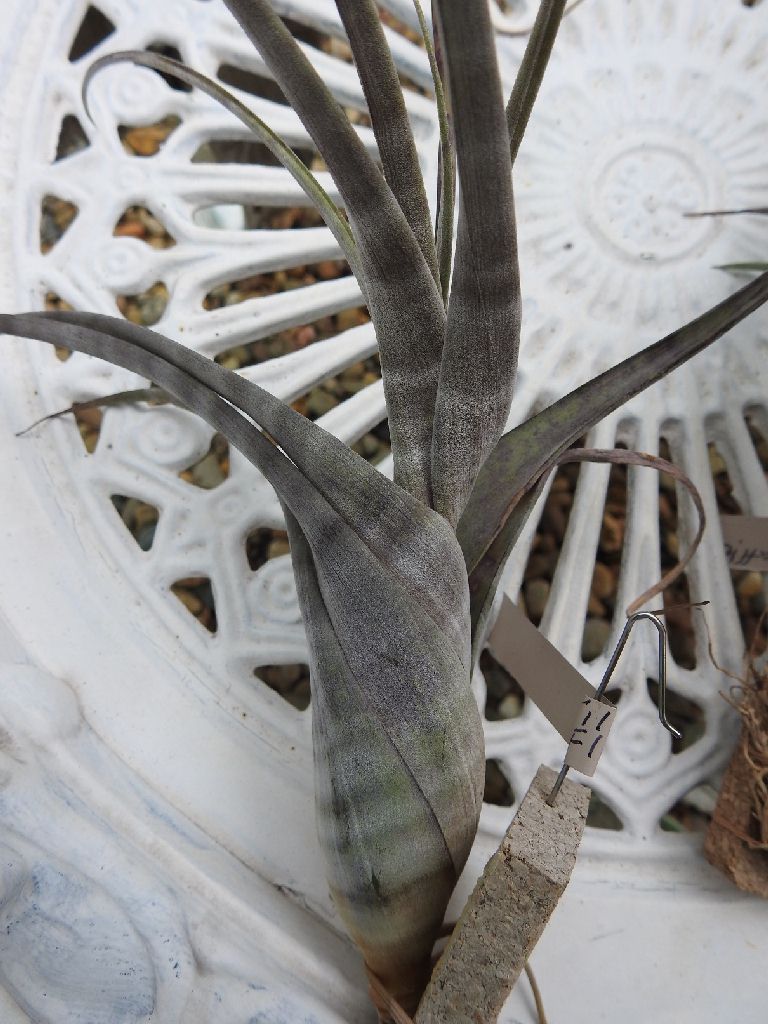
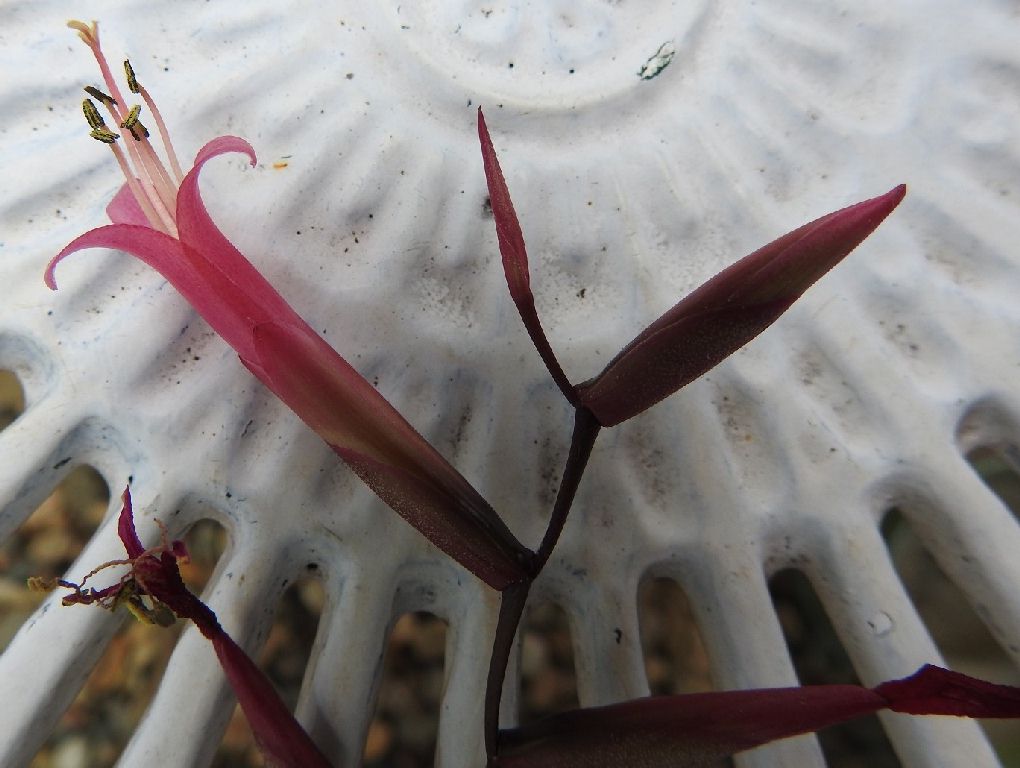

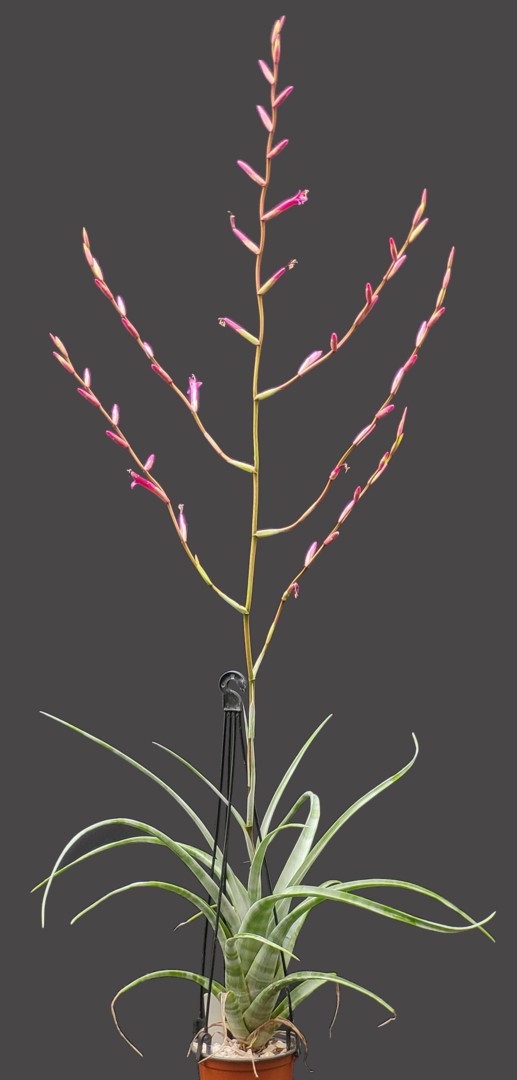

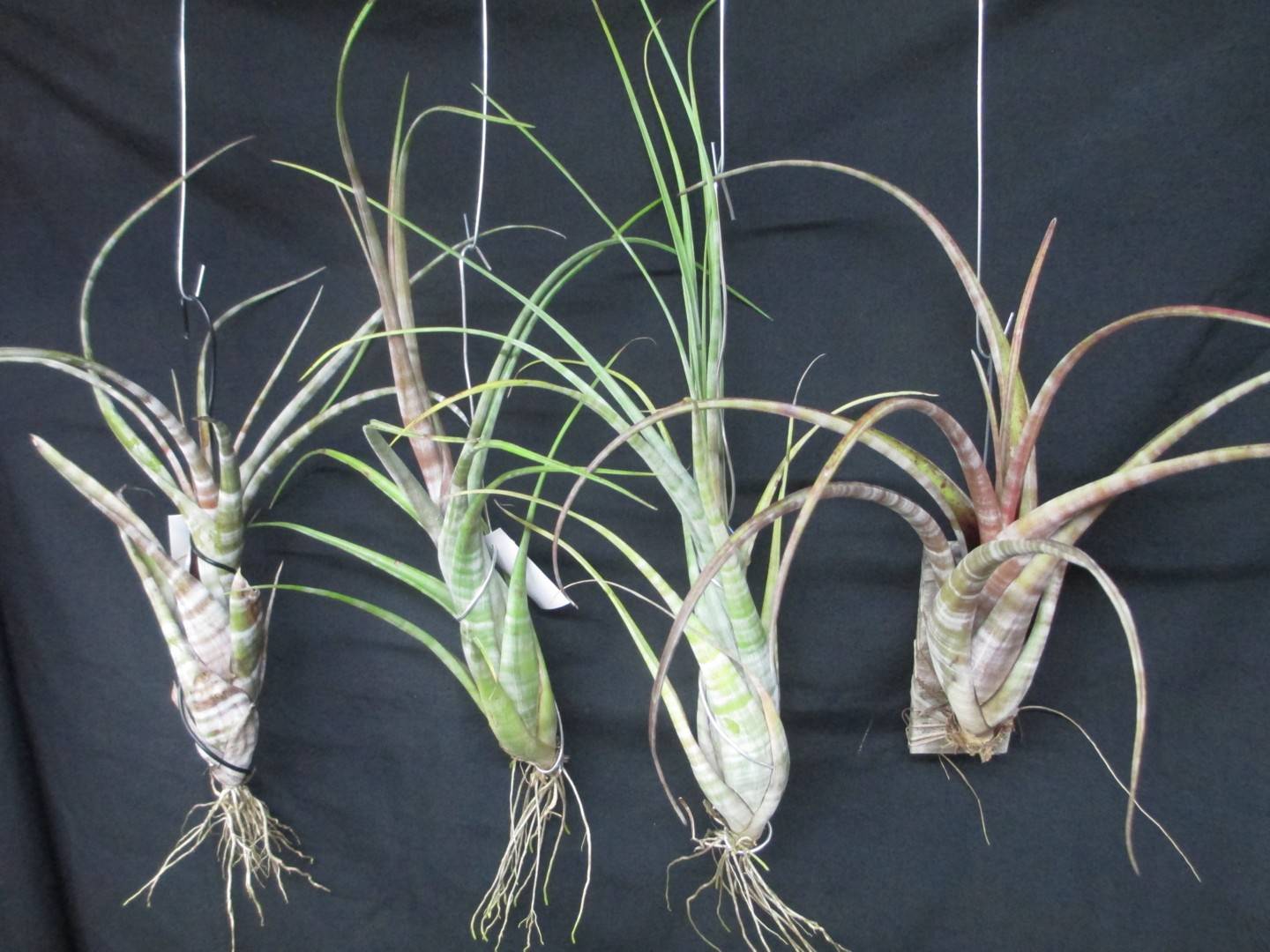
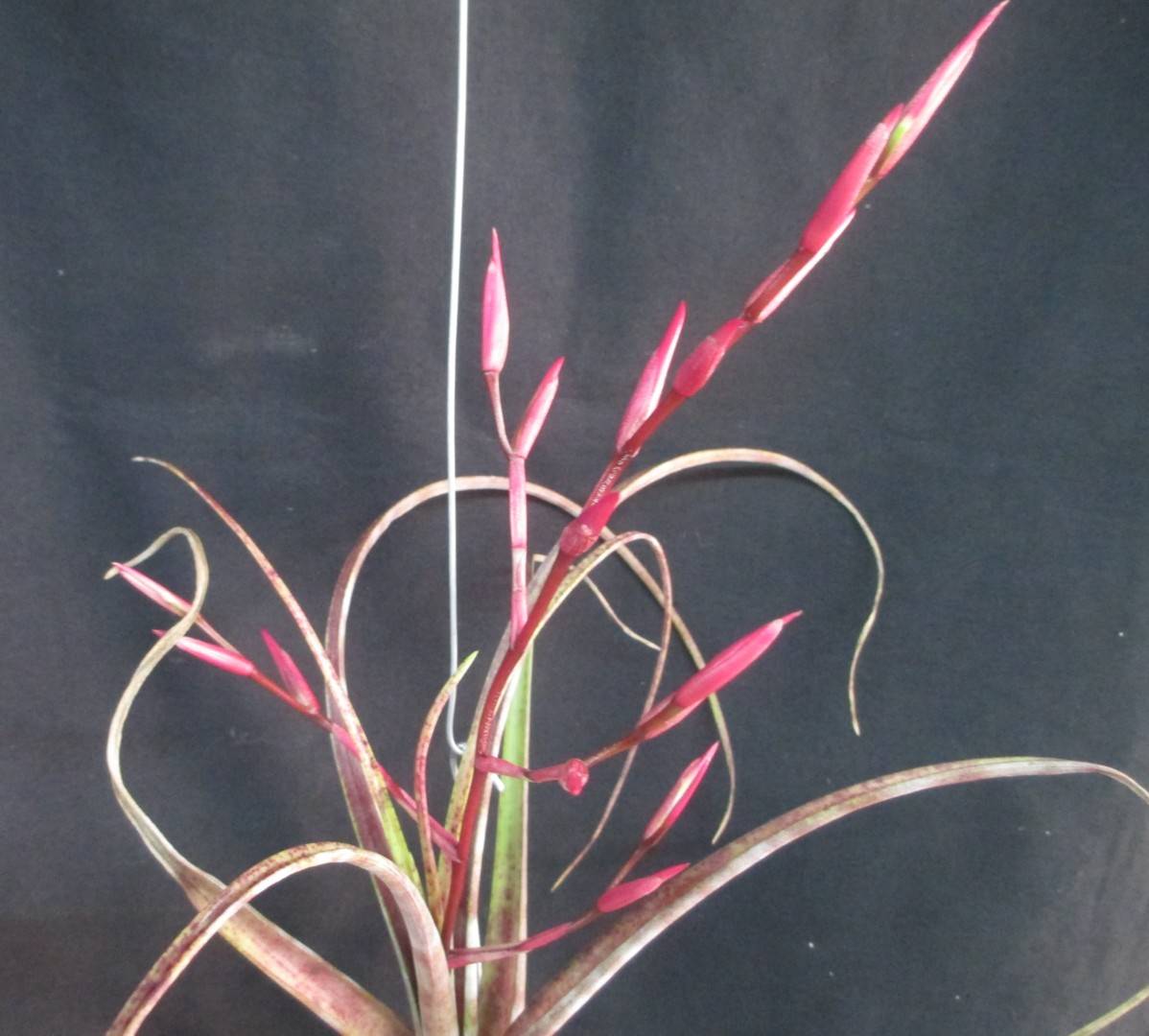
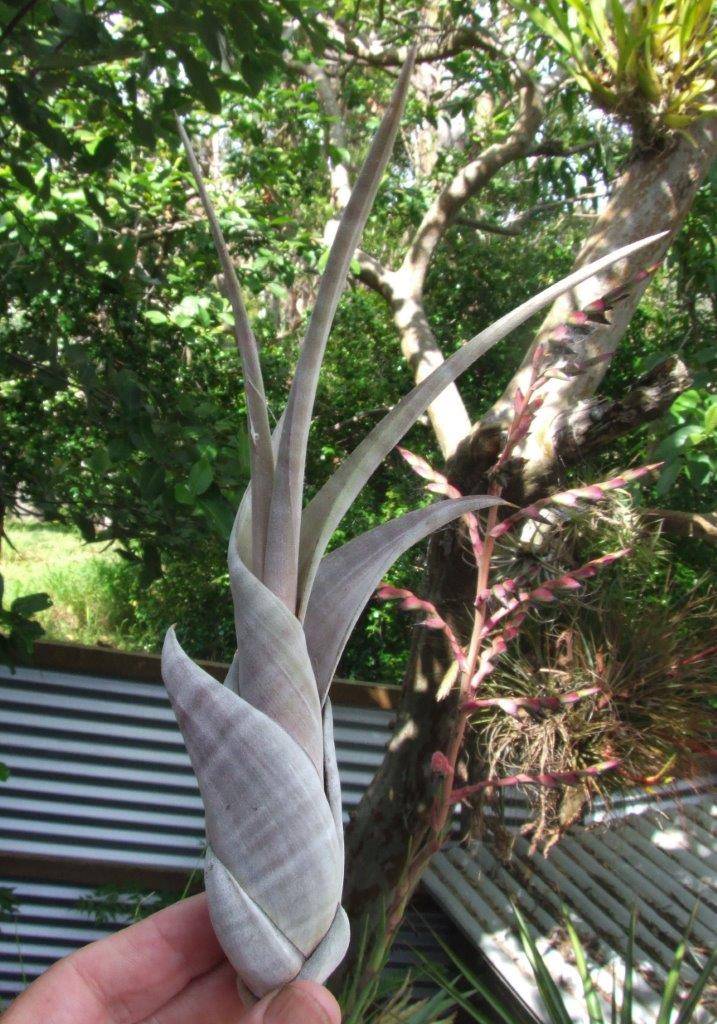

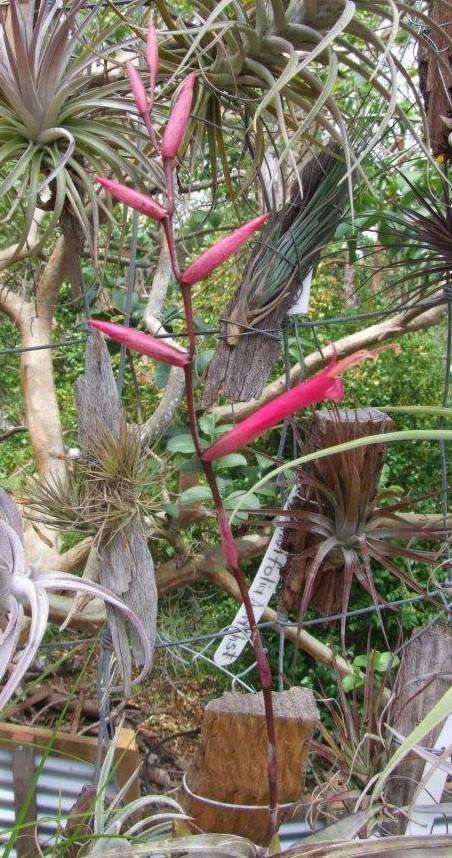




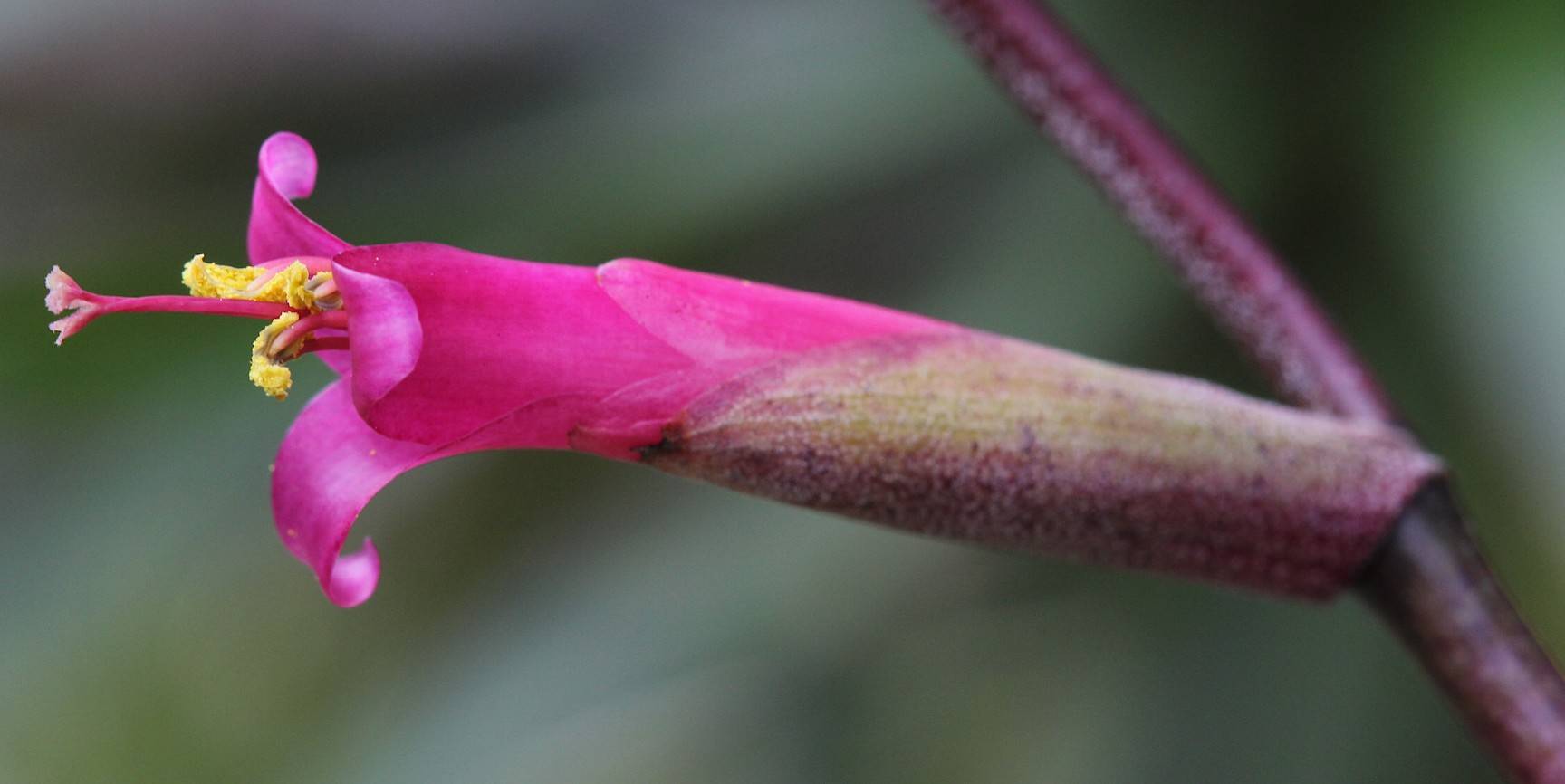
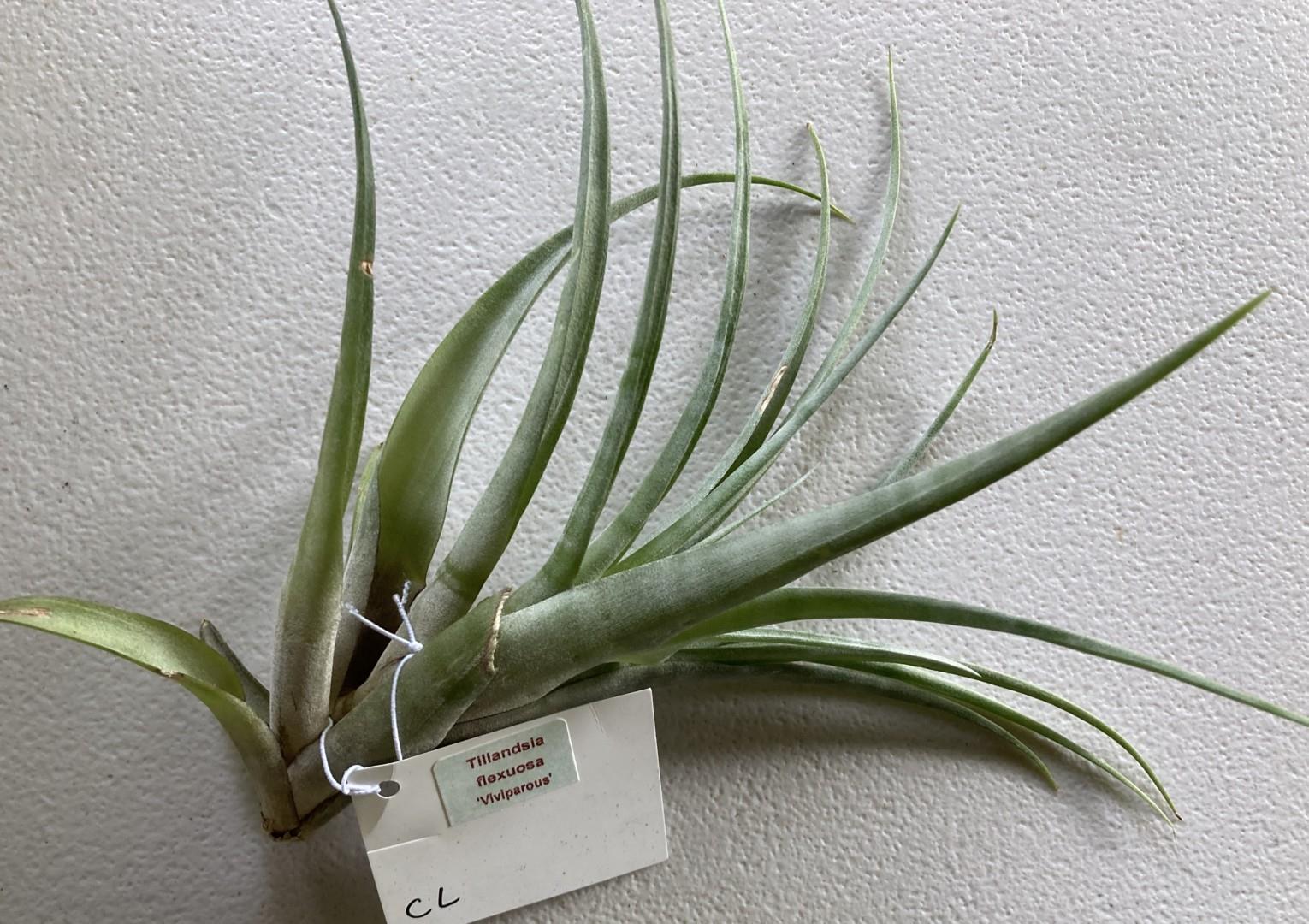
Desc from S&D p977-80
Plant stemless, 2-15 dm high.
Leaves 10-20 in a dense often sub-bulbous rosette, 2-5 dm long, densely palc-appressed-lepidote, usually marked with broad white transverse stripes, the outer bladeless, squamiform;
Sheaths ovate, very large but passing into the blade without clear distinction;
Blades narrowly triangular, about 25 mm wide, attenuate, then abruptly and pungently acute, stiff, curved.
Scape erect, slender, glabrous; scape-bracts erect, tubular-involute, elliptic, acute or obtuse, appressed-lepidote, at least the upper ones shorter than the internodes.
Inflorescence simple or very laxly bipinnate;
Primary bracts like the upper scape-bracts, much shorter than the sterile bases of the axillary branches;
Branches ascending, to 4 dm long, very laxly flowered;
Rhachis slender, flexuous, sharply angled, glabrous.
Floral bracts spreading with the flowers, elliptic, broadly acute, 2-3 cm long, equaling or shorter than the sepals, about equaling the internodes, ecarinate, chartaceous, prominently nerved, densely or sparsely appressed lepidote;
Pedicels to 7 mm long.
Sepals narrowly elliptic, obtuse, 2-3 cm long, 7 mm wide, free, subchartaceous, prominently nerved, sparsely lepidote or glabrous;
Petals tubular-erect, linear, acute, to 4 cm long, rose or purple or white; see forma alba
Stamens exserted.
Capsule slenderly cylindric, acuminate, to 7 cm long.
Type. Based on Jacquin s n (W), Cartagena, Colombia, as a nomen novum for Tilland¬sia tenuifolia sensu Jacquin.
DISTRIBUTION. Epiphytic, from near sea level to 480 m alt, southern Florida, West Indies, Panama, northern South America.
UNITED STATES. FLORIDA, Palm Beach: 23 Mar 1953, Foster 2818 (US); Lee: Myers, 1900, Hitchcock 346 (GH, US); Collier: Goodland Point, 15 Dec 1891, Simpson 490 (GH, US); Dade: Miami, 1877, Garber 92 (GH, US); Monroe: Big Pine Key, Jun 1891, Simpson 359 (US); 1936, Killip 31661 (US); 31692 (US); 1950, Killip & Swallen 40367 (US); Nov 1950, Killip 40721 (US); 40809 (US); Aug 1954, 44353 (US); Sugar Loaf Key, 17 Mar 1898, Pollard, Collins & Morris 99 (GH, US). PANAMA. CHIRIQUI: San Felix, 29 Aug 1946, Allen 3651 (MO, US). CANAL ZONE: Balboa, 1924, Standley 25499 (US); Fort Kobbe, Oct 1961, Duke 4256 (MO, US); Farfan Beach, Palo Seco, 4 Dec 1966, Burch 63 (MO, US). PANAMA: Bella Vista, 16 Oct 1922, Killip 12042 (US); Punta Paitilla, 7 Dec 1923, Standley 26248 (US); 26262 (US); 26263 (US); 12 Jan 1924, 30794 (US); Panama, Dec 1923, Standley 26838 (US); 27787 (US); 28 Jun 1940, Bartlett & Lasser 16324 (MICH); 4Jul l940, 16391 (MICH); Isla Taboga, Dec 1923, Standley 27967 (US); Ju11938, Woodson, Allen & Seibert 1488 (GH, MO); 16 Jun 1968, Smith 7 (US); Rio Tapia, 1923-24, Standley 28292 (US); Las Sabanas, 21 Jan 1924, Standley 31904 (US); Jun 1932, Zetek 901 (F). DARIEN: El Real, Rio Tuira, 11 Ju11959, Stern et al 895 (US); 30 Jun 1962, Duke 4938 (MO, US). CUBA. ISLA DE PINOS: San Pedro, 1916, Britton & Wilson 14567 (NY, US); Nueva Gerona, Curtiss s n (GH); 15 Apr 1954, Killip 44016 (US). PINAR DEL RIO: Herradura, 18 Sep 1905, Van Hermann 916 (POM); Guane, 25 Nov 1911, Shafer 1 {)515 (NY, US). HABANA: Santiago de las Vegas, 2 Ju11904, Baker & Wilson 609 (POM); 5 Oct 1905, Baker 5094 (POM); Laguna Castellana, 8 Oct 1904, Wilson 4007 (POM); Guanabacoa, 2 Jan 1905, Curtiss 587 (GH, US); Lomas de las Jatas, 14 May 1914, Ekman 878 (S); Lorna de Coca, 18 May 1914, Ekman 1{)13 (S); Morro, 27 May 1914, Ekman 1156 (S). MATANZAS: San Miguel de los Banos, Dec 1931, Killip 13923 (US). LAS VILLAS: Santa Clara, 19 Feb 1923, Ekman 16337 (S); Soledad, Cien¬fuegos, 9 Nov 1928, Jack 6636 (GH, US); 31 Jan 1930, Jack 7616 (BH, US). CAMAGUEY: La Gloria to Columbia, 6 Mar 1909, Shafer 612 (NY, US); Cayo Paloma, 12 Oct 1909, Shafer 2576 (NY, US). ORIENTE: Guantanamo, Mar 1909, Britton 2102 {NV, US); 26 Sep 1914, Ekman 2959 {S); Santiago de Cuba, 21 Oct 1916, Ekman 8012 {GH, S); 24 Aug 1952, Lopez Figueirds 610 {US). BAHAMAS. Andros, 27 Feb 1966, Dawson 26511 {US); Mar 1966, 26753 {US); 26928 {US); Crooked Island, Jan 1906, Brace 4789 {NV, US). JAMAICA. MIDDLESEX, St. Catharine: Riverhead, 29 Jan 1954, Proctor 8370 {IJ, US). CORNWALL, Trelawny: Good Hope, 27 Aug 1956, Proctor 15715 {IJ, US). WITHOUT EXACT LOCALITY: Shakespear s n {BM, probably used by Swartz in describing Tillandsia flexuosa); Jul 1844, Purdie s n {K); Harris 5671 {IJ). CAYMAN ISLANDS: Grande Cayman, 15 Apr 1956, Proctor 15005 {IJ, US); Cayman Brac, 26 May 1938, King CB-32 {BM). CAICOS ISLANDS: North Caicos, Kew, 29 Jun 1954, Proctor 9050 {IJ, US); South Caicos, 27 Jun 1954, Proctor 8990 {IJ, US). HAITI: P1aine Cu1-de¬Sac, 15 Oct 1924, Ekman H-2155 {S, US); St. Michel de l'Atalaye, Nord, 20 Nov 1925, Leonard 7306 {US); La Vallee, Tortue Island, 3 Jan 1929, Leonard 11530 {US); Cabaret, Baie des Moustiques, 13 Jan 1929, Leonard 11886 {GH, US). REPUBLICA DOMINICANA. PUERTO PLATA: Estero Hondo, Jimenez 2792 {US). MONTE CRISTI: Rio Vaque del Norte, Oct 1946, Howard 9610 {GH, US). PUERTO RICO. Santurce, 25 May 1899, Heller 1394 {NV, US). WINDWARD ISLANDS. GRENADA: Grande Ance, Dec 1889, Eggers 6465 {US). BONAIRE: Boldingh 723B {U). CURACAO: Feb 1917, Curran & Haman 112 {GH); 171 {GH, US); 172 {GH); Arnaldo 5 {U); Boldingh 4939 {U); 5010 {U); 5053 {U); 5525 {U); 6448 {U); Suringar 1 {U). ARUBA: Arnaldo 297 {U). COLOMBIA. MAGDALENA: Santa Marta, 1898-1901, Smith 2347 {F, GH, PH, US); Jun 1906, Pittier 1608 {US); 5 Apr 1927, Killip & Smith 21098 {GH, US); 29 Jul 1946, Foster & Smith 1327 {GH); Aug 1946, 1441 {GH, US); La Jagua, 8 Sep 1924, Allen 617 {MO); San Juan de Cesar, 12 Jun 1944, Haught 4198 {F, GH, US). ATLANTICO: Puerto Columbia, Ju11928, Elias 536 {US); Barranquilla, Jul 1932, Elias 786 {GH); Sabanilla, 28 Aug 1932, Dugand 88 {F); El Palmar, 1937 , Elias 1570 {F); Palmar de Varela to Ponedera, Aug 1943, Dugand & Jaramillo 3469 {COL, US); Rio Magdalena, 12 Ju11946, Foster & Smith 1263 {GH). BOLIVAR: Island of Mompos, Lands of Loba, 1916, Curran s n {US); Cartagena, 1920, Heriberto 355 {US); Tierrabomba Island, Cartagena Bay, 4 Nov 1926, Killip & Smith 14118 {GH); Turbaco, Nov 1926, Killip & Smith 14222 {GH, US); 14261 {GH, US); Arjona, 15 Nov 1926, Killip & Smith 14529 {GH, US). CORDOBA: El Sinu, Monteria, 7 Jan 1949, Zainum, Araque & Barkley 19-Bo-089 {US). NORTE DE SANTANDER: Cucuta, Feb 1941, Carvajalino & Diaz 35 {COL). CUNDINAMARCA: Tocaima, Dec 1932, Arbelaez 2099 {US); El Paso, Girardot to Melgar, 7 Aug 1939, Arbelaez & Cuatrecasas 6558 {US); Apulo, Anapoima, 4 May 1944, Killip, Dugand & Jaramillo 38159 {US). TOLIMA: Caracoli, Rio Magdalena, 12 Dec 1875, Andre 695 {F); Flandes, 14 Dec 1946, Schneider 226 {COL); Ibague, 1 Aug 1952, Koie 5139 {C). HUILA: Quebrada de Angeles to Rio Cabrera, 25 Jul1917 , Rusby & Pennell 321 {US); Villavieja to Baraya, 4 Ju11950, Smith 1138 {US). VAUPES: Vapoboda, 1°20' N, 70°30' W, Apr 1953, Schultes & Cabrera 20036 {COL, US); 25 Jun 1958, Garcia Barriga, Schultes & Blohm 17838 {US). VENEZUELA. NUEVA ESPARTA: Isla Coche, 1903, Johnston 15 {GH); Los Frailes, Dec 1951, Gines 2828 {US); Guetamare, Dec 1951, Gines 2837 {US). SUCRE: Cristobal Colon, 1923, Broadway 27 {GH, US); 603 -(GH, US); Paria Peninsula, Pittendrigh 1207 {US); Patos Island, 5 Mar 1958, Aitken & Downs s n {US); Hierro, 24 Ju11962, Steyermark & Agostini 91308 {US, VEN). ANZOATEGUI: Guanta, 1 Jul 1917, Curran & Haman 1220 {GH). DISTRITO FEDERAL: La Guaira, 9 Aug 1900, Robinson & Lyon s n {US); Hacienda Puerto La Cruz, Coastal Range, 4 Sep 1918, Pittier 8100 {US, VEN); Cerro La Casquilla, km 27 Caracas to La Guaira, 20 Jan 1947, Lasser 2289 {VEN); Naiguata, 3 Nov 1963, Steyermark 91933 {US, VEN). ARAGUA: Maracay, 1934, Vogl 1069 {M); 1073 {M); 4 Sep 1963, Montaldo 3645 {VEN); Choroni, 1938, Vog1 A-39 {M); Cansa Macho, Rancho Grande, 17 Oct I95I, Foster2763 {US). CARABOBO: El Palito to Puerto Cabello, 26 Dec 1891, Warming 513 {C); 24 Jun 1917, Curran & Haman 1133 {GH); 5 Jan 1939, Alston 6098 {BM); 6 Apr 1950, Fernandez 712 {VEN); 16 Nov 1957, Trujillo 3870 {VEN); San Joaquin, Jul 1918, Pittier 7926 {GH, US); Cabo Blanco {?), 1917, Curran & Haman 933 {GH); 950 {GH); Las Trincheras to Puerto Cabello, 27 Dec 1938, Alston 5718 {BM); Patanemo to Puerto Cabello, 19 Oct 1962, Trujillo 5360 {VEN). FALCON: Paraguana, Dec 1953, Lasser & Aristeguieta 3352 {VEN); 77 km south of Coro, 25 Jan 1966, Steyermark & Braun 94725 {VEN). LARA: Siquesique, 2 Sep 1959, Trujillo 4773 {VEN); El Eneal, Tamaca to Cordero, 28 Ju11963, Fernandez 365 {VEN). ZULIA: Rio Vasa, Machiques, 24 Aug 1967, Steyermark & Fernandez 99641 {VEN); 99730-A {VEN). MERIDA: Merida, Jan 1950, Marcuzzi s n {US); Rio Chama, Estanquez to Puente Real, Sep 1966, Steyermark 97032 {VEN). TACHlRA: San Antonio, 8 Aug 1950, Cardona 4234 {VEN). BOLIVAR: Ciudad Bolivar, 1921, Bailey 1536 {BH); Las Nieves to Cerro Pechacho, Feb 1961, Steyermark 89294 {NV, US, VEN). AMAZONAS: Esmeralda, 18 Oct 1928, Tate 228 {NV); 15 May 1942, Williams 15402 {US); Puerto Ayacucho, 23 May 1940, Williams 13092 {US); Jun 1940, 13482 {VEN); 25 Jun 1942, 15881 {US); 11 Sep 1944, Steyermark 58526 {F, GH); Rio Orinoco opposite Rio Atabapo, 4 Aug 1959, Wurdack & Adderley 43752 {NV, US). TRINIDAD. Gasparee, 1861, Herb. Trin. 846 {TRIN); San Fernando, 1873, Herb. Trin. 2011 {TRIN); Port of Spain, 1906, Hart s n {TRIN); 1930, Broadway s n {GH); Erin, 1915, Broadway 7337 {TRIN); Icacos, St. Quinton, 1915, Broadway 7372 {TRIN); L'Islet, Chatham, 1916, Broadway 8649 {TRIN); Chacachacare, 1921, Broadway 10571 {TRIN); 18 Mar 1956, Aitken s n {US); Patos, 1921, Broadway s n {TRIN); Aitken s n {TRIN); Cedros, Pittendrigh 41 {US); Gaspar Grande, 1944, Pittendrigh 1180 {US); Princes Town, Downs s n {TRIN); Toco, 3 Jul 1955, Aitken & Downs s n (US); Maraval. Simmons 194 (TRIN); Purseglove 6167 (TRIN); Huevos Island, 19 Ju11959, Aitken s n (US). TOBAGO. Concordia. Oct 1889, Eggers 5667 (GH, US); Calder Hall, 4 Feb 1914, Broadway 4746 (US); Charlotteville, 18 Jul 1955, Aitken s n (US); Barbados Bay, 1 Aug 1957, Aitken s n (US); Mason Hall, Aitken s n (TR1N); Little Tobago Island. 3 Aug 1963, Aitken 5 n (US); Pigeon Point Swamp, 16 Nov 1965, Aitken s n (US). GUYANA. DEMERARA: Hooroobea and Lama, 1887, Jenman 3827 (BRG). ESSEQUIBO: Bartica, 1922, Cruz 2026 (GH, NY. US). SURINAME. Paramaribo, Wullschlaegel 509 (BR); Mar 1838, Splitgerber 610 (L); s d. Kegel 436 (GOET); 1048 (GOET); Kramer & Hekking 2128 (U); 2628 (U); Misikai. upper Suriname River, Tresling 130 (U); upper Coppename River, Saramacca, 10 Sep 1961,Hekking999 (U). FRENCH GUIANA. ? 1961, Schnell 11434 (P).
Tillandsia flexuosa Swartz forma alba H. Takizawa, Journ. Brom. Soc. 53(2):54-5. 2003.
TYPE: Costa Rica. Puntarenas: Epiphyte on mangrove forest of peninsula de Osa, GPS coordinates 08°32.40'N, 83°17.97'W, sea level, 14. Sep. 1999, Hiroyuki Takizawa, Dennis Cathcart & Chester Skotak TH990914f (Holotype: SEL).
A typo differt characteribus sequentibus: inflorescentia alba, scapus albus, bracteis, sepalis, petalis et staminibus alvissimis, pistillo albo et pollinibus flavis.
Plant stemless, flowering 5-8 dm high.
Leaves 10-20, in a dense subbulbous rosette, 2-5 dm long, densely pale-appressed, lepidote, usually marked with broad white transverse stripes, the outer bladeless, squamiform, shorter than the inflorescence.
Leaf sheaths ovate, very large but passing into the blade without clear distinction.
Leaf blades narrowly triangular, ca. 25 mm wide, attenuate, then abruptly and pungently acute, stiff, curved.
Scape erect, slender, glabrous.
Scape bracts erect, tubular-involute, elliptic, acute, appressed lepidote, at least the upper ones shorter than the internodes.
Inflorescence simple, 5-11 very laxly flowered, whitish-yellow.
Floral bracts spreading with the flowers, elliptic, broadly acute, 3 cm long, 1 cm wide, equaling or shorter than the sepals, about equaling the internodes, ecarinate, chartaceous, prominently nerved, sparsely appressed-lepidote, whitish-yellow.
Flowers pedicellate 5-7 mm, opening during the day.
Sepals narrowly elliptic, acute, ca. 2 cm long, 7 mm wide, free, subchartaceous, prominently nerved, sparsely lepidote or glabrous, whitish-yellow.
Corolla tubular.
Petals linear, acute, 38 mm long, pure white.
Stamens 3 of 40 mm long and 3 of 45 mm long, exserted, pollen grains yellow.
Style 40 mm long, exserted.
Overall, the floral characteristics of this new form lie within the normal size range of the type of Tillandsia flexuosa. When in bloom, however, this new form has an unmistakable bright yellow inflorescence and pure white flower. It is rare among plants of this type.
Habitat: The plant grows in a very bright beach area of Gulfo Dulce where mangroves make a small forest. The plant has ants nesting in its pseudobulb and other insects were living nearby.
Detail from Gouda in Flora of the Guianas 1987
11.Tillandsia flexuosa Swartz,Prod. Veg. Ind. Occ. 56. 1788; as a nom. nov. for Tillandsia tenuifolia sensu Jacquin, Set. Stirp. Am. 92: pl. 63. 1763; non Linnaeus, 1762. - Vriesea tenuifolia Beer, Bromel. 96. 1857; in part, as to Tillandsia tenuifolia sensu Jacquin, not as to type. Type: Colombia, Cartagena, Jacquin s. n. (W). Specimen now lost, but name adequately typified by description and illustration. - Plate 12.
Tillandsia flexuosa Swartz a fasciata Lindley, Bot. Reg. 9: sub pl. 749. 1823. Based on Tillandsia tenuifolia sensu Jacquin.
Tillandsia aloifolia Hooker, Exot. Fl. 3: pl. 205. 1827. - Vriesea aloifolia (Hooker) Beer, Bromel. 95. 1857; as "aloefolia". Type: De Schach in Glasgow Hortus (K, US photo).
Plant acaulescent, flowering 50-95 cm long, with a 20-35 cm tall flexuous-tubular or narrowly funnelform rosette, of 10-20, often twisting and transversely white-banded, leaves, sometimes with offset on the scape of the inflorescence.
Leaves stiff-coriaceous, 20-40 cm long, normally shorter than the scape, the outer ones reduced and bladeless, densely appressed-lepidote, usually with transverse bands of extended spreading scales outside;
sheaths large, but not very distinct, evenly merging into the blades, ovate, inflated, 5-9 x 2.5-5 cm, often deep purple at the (membranaceous) margins;
blades arching and often twisting in one direction, very narrowly triangular, becoming involute toward the apex when dry, 20-30 x 1.8-3.5 cm, attenuate, then (abruptly) pungent.
Inflorescence simple or laxly bipinnate of 2-6 distichously arranged branches, 45-88 cm long;
scape erect, 23-50 cm long, 2-4 mm in diam., almost entirely glabrous, dark green, for most part covered by bracts;
scape bracts erect, chartaceous, elliptic, the lower ones imbricate and with foliaceous blades, the upper ones more apiculate or subacute and somewhat shorter than the internodes, densely appressed-lepidote;
axis elongate, wholly exposed, flexuous, at least toward the apex, sharply angled (when dry), for most part glabrous or sparsely lepidote;
primary bracts like the upper scape bracts, clasping the branches, much shorter than the peduncle;
peduncle 6-10 cm long, sparsely lepidote at one side, with one or two remote bracts;
racemes spreading, often ascending, elongated, 8-25 cm long, very laxly and distichously 3-10-flowered, with one sterile bract at the apex;
rachis entirely visible, slender, flexuous, sharply angled, subglabrous;
floral bracts spreading, clasping the flower, chartaceous, with prominently veined surface (when dry), elliptic, 2-3 cm long, about equaling the internodes, much exceeded by the sepals, membranaceous at the margins, broadly acute or rounded and obscurely apiculate, ecarinate, appressed-lepidote.
Flowers spreading, distinctly pedicellate (to 1 cm long);
sepals subchartaceous, with prominently veined surface when dry, narrowly elliptic, 2-3 cm long, obtuse, free, ecarinate, sparsely lepidote or glabrous;
petals erect, divergent or coiled at the apex, to 4 cm long, acute, purple-rose (or white?);
stamens exserted, unequal, exceeded by the pistil (at least the 3 shorter ones), filaments straight, flat, except at the apex, anthers dorsifixed (at 2/5), ca. 3 mm long;
ovary ovoid, ca. 5 mm long, style slender, stigmas linear (bristle-like).
Capsule slenderly cylindric, to 7 cm long, 2-3 times as long as the floral bracts, evenly tapering toward the apex, then abruptly short-beaked.
Distribution: S. Florida, West Indies, Panama, N. South America. Epiphytic, from near sea level to 1200 m alt. 23 collections studied (7-GU, 6-SU, 7-FG).
Culture and use: A very decorative species that can be grown like an epiphyte in window at a bright and sunny location, or a dry location in greenhouse, it demands little watering, and can be propagated by seed on vertical gauze.